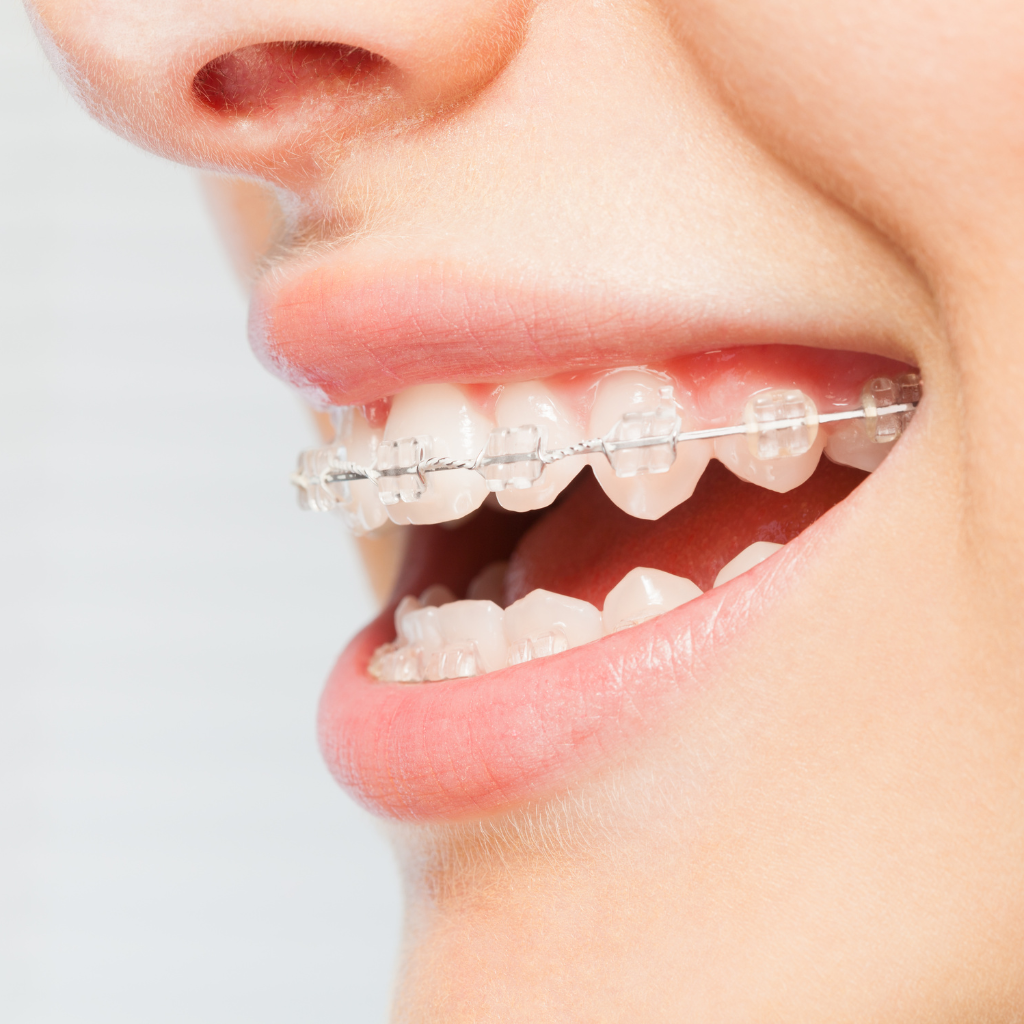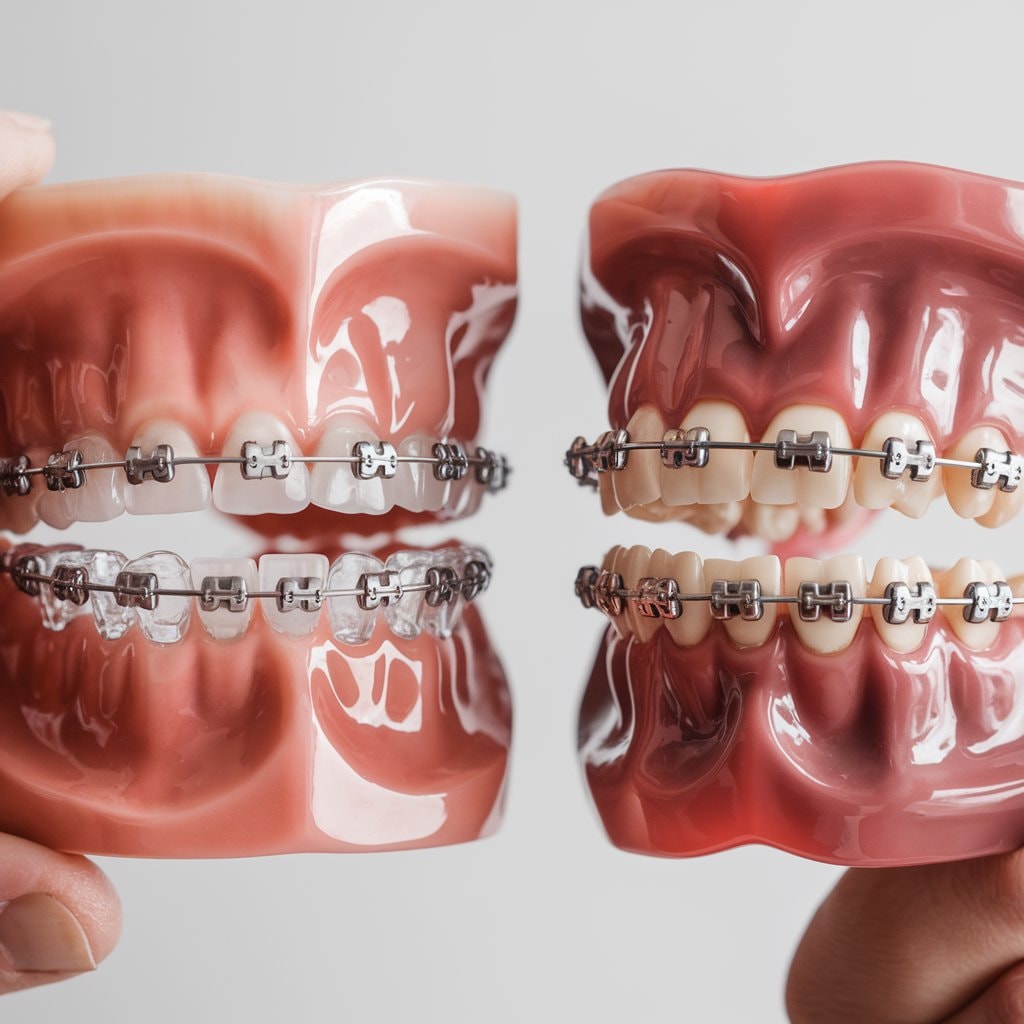Ceramic braces, made from polycrystalline alumina, offer an aesthetic advantage as they blend with the teeth’s natural colour, whereas metal braces are constructed from stainless steel and are more visible. Metal braces are often preferred for their durability and faster treatment effectiveness. In contrast, ceramic braces, though visually less obtrusive, may carry a higher cost and are more prone to staining and breakage. Exploring these options further will illuminate additional benefits and considerations based on individual orthodontic needs.
Key Takeaways
- Ceramic braces are less visible due to tooth-coloured materials, while metal braces are more noticeable with their shiny, stainless steel appearance.
- Metal braces offer greater durability and require fewer adjustments compared to the more brittle ceramic braces.
- Ceramic braces typically cost more than metal braces, influenced by material costs and aesthetic considerations.
- Treatment with metal braces is often faster than with ceramic braces, which may require longer durations to achieve similar results.
- Ceramic braces are prone to staining and require careful maintenance, whereas metal braces are generally easier to manage.
What Are the Key Differences Between Ceramic and Metal Braces?
In exploring the key differences between ceramic and metal braces, it is essential to take into account their mechanisms of action, materials composition, and visual impact.
Metal braces are typically made from high-grade stainless steel, which guarantees durability. In contrast, ceramic braces are constructed from composite materials that offer a colour-matching advantage, blending more seamlessly with the natural color of teeth.
The choice between these two types often hinges on the balance between aesthetic discretion and structural robustness.
How Do Metal and Ceramic Braces Work?
Both ceramic and metal braces employ a similar mechanism to straighten teeth, involving brackets attached to the teeth and linked by an archwire, which slowly guides the teeth into proper alignment, often requiring the consumption of soft foods during the initial adjustment period. For those wondering about the best foods to eat after getting braces, it’s crucial to opt for softer, less chewy options that won’t put pressure on the braces while they adjust. The primary goal of both types of braces in orthodontic treatment is to align teeth into their proper alignment through controlled movements. Ceramic braces offer aesthetically pleasing tooth-coloured brackets, while metal braces consist of more noticeable metal brackets and wires.
| Feature | Metal Braces | Ceramic Braces |
|---|---|---|
| Brackets | Metal | Tooth-colored |
| Visibility | Highly visible | Less visible |
| Purpose | Teeth straightening | Teeth straightening |
| Wire | Metal wires | Usually metal wires |
Both options effectively provide the necessary orthodontic force to reposition teeth over time.
What Materials Are Used in Ceramic and Metal Braces?
Understanding the materials used in ceramic and metal braces reveals fundamental differences in their composition and functionality.
Ceramic braces use polycrystalline alumina, a clear material that seamlessly matches the natural colour of teeth. In contrast, metal braces typically employ brackets made of stainless steel, known for its strength and durability.
- Ceramic Braces: Made from polycrystalline alumina, offering aesthetic appeal due to its tooth-like colour.
- Metal Braces: Use brackets made of high-grade stainless steel, which guarantees robustness and resistance to corrosion.
- Visibility: Ceramic braces are less conspicuous compared to the metallic shine of stainless steel.
- Durability: Stainless steel brackets are known for superior strength, making metal braces more durable than ceramic options.
Which Type of Braces Is Less Noticeable?
Reflecting on the materials utilized in both ceramic and metal braces highlights their distinctive visual and structural characteristics.
When comparing ceramic braces vs metal braces, ceramic options are generally less noticeable than traditional metal braces. This is primarily due to their clear or tooth-coloured brackets that blend more seamlessly with the wearer’s natural tooth color, ensuring a more discreet appearance.
In contrast, metal braces, with their more prominent and reflective surfaces, are more visible. Consequently, individuals seeking a subtle appearance often prefer ceramic braces as they are less noticeable than metal braces.
The choice between clear braces and metal greatly affects the visual impact of orthodontic treatment, with ceramic braces offering an advantaged aesthetic discretion. However, it’s important to note their potential for gum recession.
Are Ceramic Braces the Best Option for You?
Determining whether ceramic braces are the most suitable choice involves considering several factors, including aesthetic preferences, cost, and oral health conditions.
Patients should evaluate the differences between ceramic and metal braces to make an informed decision that aligns with their personal and dental needs.
Consulting with an orthodontist is essential, as they can provide professional advice and tailor recommendations based on the individual’s specific orthodontic requirements.

Factors to Consider When Choosing Braces
When choosing braces, it is critical to evaluate several factors to determine whether ceramic braces are the best option for you.
- Aesthetic Preferences: Ceramic braces are less noticeable compared to metal braces, which may be preferable for those concerned about visual appearance.
- Durability Concerns: Metal braces are more durable than ceramic. Considering the disadvantages of ceramic braces, such as their propensity to break, is important.
- Cost Considerations: Generally, ceramic braces cost more than their metal counterparts. Budget constraints might influence the decision.
- Treatment Specifics: Consult with an experienced orthodontist to discuss treatment options and assess which type of braces—ceramic or metal—aligns better with your specific orthodontic needs.
How to Decide Between Ceramic or Metal Braces?
After considering various factors like aesthetic preferences, durability, cost, and treatment specifics, individuals faced with the decision of choosing between ceramic and metal braces can make an informed decision.
Ceramic braces offer a more discreet appearance compared to metal braces, making them appealing to those who prioritize aesthetics. However, metal braces tend to be more durable and cost-effective.
The noticeable difference between ceramic and metal braces regarding visibility often guides the initial preference. When choosing the right braces, one must weigh the advantages and disadvantages of ceramics, such as their less noticeable nature against their susceptibility to staining.
Ultimately, whether to opt for metal or ceramic braces hinges on balancing personal priorities with practical considerations.
Consulting with an Orthodontist for the Right Decision
To guarantee that individuals opt for the best type of braces based on their unique dental needs and lifestyle preferences, consulting with an orthodontist is an essential step.
The orthodontic team can offer a tailored treatment plan that considers the specific orthodontic requirements of each patient.
- Assessment of Dental Needs: Thorough evaluation to determine if ceramic braces or metal braces are better suited for the individual’s condition.
- Lifestyle Considerations: Discuss daily activities to see how braces might impact them.
- Visibility and Aesthetics: Considering the aesthetic differences between ceramic and metal braces.
- Maintenance and Care: Guidance on proper care needed for ceramic versus metal braces, guaranteeing durability and effectiveness.
Consulting with an orthodontist for the right decision assures that the braces chosen align perfectly with both health requirements and personal preferences.
How Do Ceramic Braces Compare to Metal Braces in Terms of Cost?
When comparing the costs of ceramic and metal braces, several factors must be considered.
These include the initial price of the braces themselves, ongoing maintenance costs, and the coverage provided by dental insurance plans.
A detailed examination of these elements will reveal the financial implications of choosing ceramic braces over their metal counterparts.
Factors Affecting the Ceramic Braces Cost
While both ceramic and metal braces serve the essential function of aligning teeth, the cost of ceramic braces is typically higher due to several influencing factors.
- Material Costs: Ceramic braces use tooth-coloured or clear brackets that are more expensive to manufacture than traditional metal braces with stainless steel brackets.
- Aesthetic Appeal: The discreet treatment offered by ceramic options appeals to adults and teens, leading to higher demand and cost.
- Insurance Coverage: Ceramic braces cost may not be fully covered by dental insurance plans as they are sometimes considered a cosmetic option.
- Durability and Maintenance: Ceramic counterparts require more meticulous maintenance, which can add to the overall cost due to more frequent adjustments and potential replacements.
Cost Comparison: Ceramic Braces vs Metal Braces
Although ceramic braces offer aesthetic advantages, they are generally more expensive than traditional braces, which can be a deciding factor for many. The difference in braces cost arises because ceramic braces are less noticeable, leading many to prefer ceramic despite the higher price.
Ceramic braces are strong and are a good choice for those seeking discretion. However, metal braces may be more cost-effective for patients on a budget.
In comparison, the ceramic braces vs metal braces debate often hinges on the balance between aesthetic preference and financial considerations.
It’s important to acknowledge that while ceramic braces differ in appearance, both types effectively align teeth.
Ultimately, the decision may depend on individual priorities and financial circumstances.

Does Insurance Cover Ceramic or Metal Braces?
Generally, insurance policies that cover orthodontic treatment tend to provide similar levels of coverage for both ceramic braces and metal braces. However, the specific coverage details can vary by plan.
- Material Coverage: Most plans do not differentiate between ceramic braces and metal braces since braces use a similar design principle.
- Cosmetic Surcharge: Some insurers may cover the functional aspect but might charge extra for the aesthetic difference in ceramic braces.
- Annual Maximums: Coverage often has a cap, which could affect the total out-of-pocket cost regardless of brace type.
- Pre-approval Requirements: Certain policies require pre-approval for orthodontic procedures, which is essential for patients planning to get braces.
What Are the Pros and Cons of Metal Braces?
Evaluating metal braces involves understanding their advantages and limitations alongside their structural resilience.
Benefits such as cost-effectiveness and robustness are pivotal, yet they come with aesthetic and comfort drawbacks that warrant consideration.
The inherent durability of metal braces, a significant advantage, stems from their high-quality stainless steel construction, which endures the rigors of orthodontic adjustments effectively.
Benefits of Traditional Metal Braces
Conventional metal braces, recognized for their strength and efficiency, offer several advantages over other orthodontic options.
These traditional types of braces, commonly referred to as metallic braces, are particularly beneficial for those who play contact sports due to their robustness.
The structure of metal braces allows for frequent adjustments, which is essential for achieving a healthy smile.
- Durability: Metal braces are strong enough to withstand the rigors of contact sports.
- Effective Treatment: Allows for precise and frequent adjustments, speeding up treatment time.
- Visibility of Progress: The noticeable nature of metal braces helps in monitoring progress.
- Support for Accessories: Easily integrates with rubber bands and other orthodontic accessories for complex corrections.
Drawbacks of Metal Braces
Despite their numerous benefits, metal braces also present several drawbacks that may affect an individual’s decision to choose them, requiring diligent oral hygiene to maintain their effectiveness. One notable concern is the look of metal braces, which some may find less aesthetically pleasing than less noticeable options like ceramic braces.
The traditional type of metal can trap food particles, necessitating diligent oral hygiene to prevent issues such as tooth decay and gum disease. This requirement for meticulous cleaning can be burdensome for some users.
Additionally, while metal braces are effective for correcting severe misalignments, their conspicuous nature might detract from a user’s confidence, especially among adults.
Understanding these pros and cons is essential for anyone considering this orthodontic solution to make an informed decision.
Why Are Metal Braces More Durable?
While metal braces are often criticized for their aesthetic impact, they are renowned for their durability; This makes them a popular option for many orthodontic patients.
- Material Strength: Metal braces, typically made from stainless steel or titanium alloys, are more robust than ceramic braces, which can chip or crack.
- Longevity: They withstand everyday wear and tear better, maintaining their integrity throughout the treatment time.
- Maintenance: Metal braces are less likely to stain compared to tooth-coloured or clear braces, making them more stain-resistant.
- Versatility: They are suitable for treating more complex dental issues, which might not be manageable with less durable types like ceramic or clear braces.

What Are the Pros and Cons of Ceramic Braces?
Ceramic braces offer a distinct advantage regarding aesthetics, as they are less noticeable compared to metal braces due to their colour-matching ability with teeth.
However, they may present some disadvantages, such as higher cost and potential for staining if not properly maintained.
It is essential to evaluate these factors alongside the visual discretion they provide to make an informed decision about orthodontic treatment.
Advantages of Ceramic Braces
Ceramic braces offer a significant aesthetic advantage over their metal counterparts due to their transparency, which makes them less noticeable on the teeth. This feature aligns closely with personal preferences for a more natural appearance while straightening teeth.
- Aesthetic Appeal: Ceramic braces, often referred to as clear braces, blend seamlessly with natural teeth, providing a discreet option for orthodontic patients.
- Colour Matching: Clear brackets can be tailored to match the shade of the patient’s teeth, enhancing cosmetic appeal.
- Social Confidence: Less visible than metal braces, ceramic options are favoured by adults and teens concerned about their visual dental appearance.
- Material Innovation: Modern ceramic materials offer robustness comparable to metal, minimizing the difference in performance between the two types while maximizing cosmetic benefits.
Disadvantages of Ceramic Braces
Despite their aesthetic benefits, ceramic braces also present several drawbacks that patients should consider before deciding on their orthodontic treatment.
One issue with ceramic braces is their tendency to stain, especially if not properly maintained. Even though ceramic braces are often less visible, they require diligent care to guarantee that the ceramic brackets do not discolour.
Moreover, ceramic braces are also more brittle compared to metal braces. This fragility increases the risk of bracket breakage, necessitating more frequent visits to the orthodontist for repairs.
Additionally, patients wearing ceramics may find that these braces exert more pressure on the teeth due to their bulkier size, potentially leading to discomfort.
Consequently, while braces may be a better aesthetic choice, their maintenance and durability could pose challenges.
Are Ceramic Braces Less Visible Than Metal Braces?
Ceramic braces, often called clear braces, blend more seamlessly with the natural color of teeth, making them less noticeable than traditional metal braces. This aesthetic advantage is particularly significant for those conscious about wearing braces.
- Colour Matching: Ceramic braces match the colour of teeth, unlike metal braces.
- Smooth Edges: Designed with smooth edges, they are less likely to irritate soft tissues.
- Less Visible: Though ceramic, they are subtler than metal options.
- Alternative Options: For those prioritizing invisibility, clear aligners or invisible aligners offer even less visibility.
Ceramic braces are one viable solution for those seeking orthodontic treatment with a concern for aesthetics.
Conclusion
To summarize, when choosing between ceramic and metal braces, consider factors such as aesthetics, cost, and durability. Ceramic braces offer a less noticeable option, though they may carry a higher price tag and can be more fragile than their metal counterparts. Metal braces, on the other hand, are highly durable and cost-effective but are more visible. Each type has distinct advantages and disadvantages, making it essential to consult with an orthodontist to determine the most suitable option for individual orthodontic needs.


